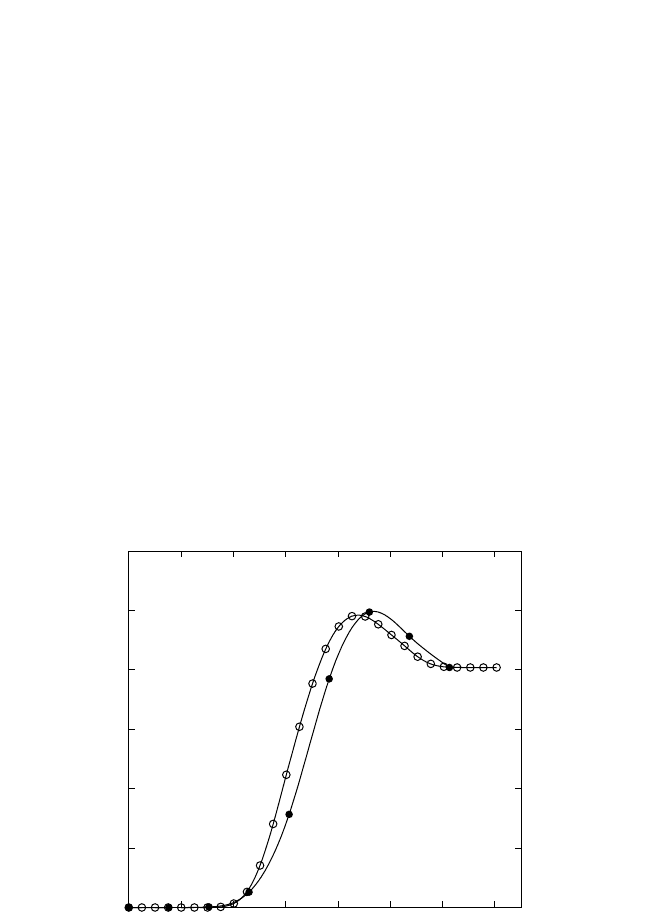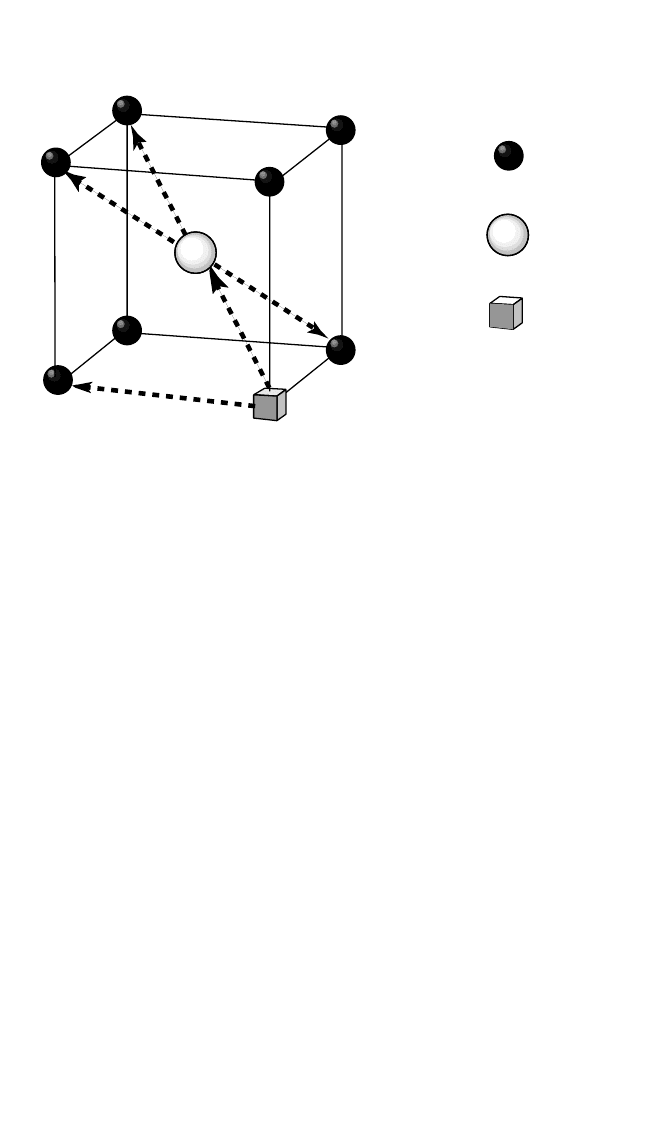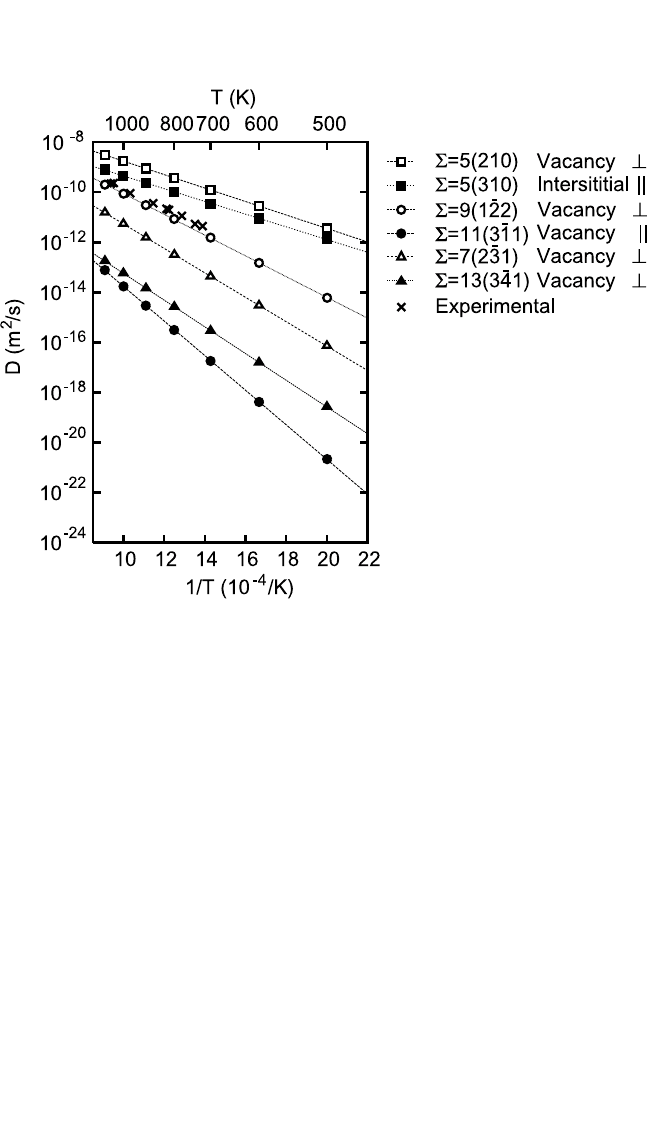Gupta D. (Ed.). Diffusion Processes in Advanced Technological Materials
Подождите немного. Документ загружается.


142 DIFFUSION PROCESSES IN ADVANCED TECHNOLOGICAL MATERIALS
elastic forces normal to it are eliminated at each step of the relaxation. It
turns out that the relaxed elastic band positions itself approximately along
the MEP and thus passes through the saddle point
[98, 99]
[Fig. 4.4(b)]. The
image with the highest potential energy is, therefore, taken as an approxi-
mation to the saddle point. The latter can be located more precisely by
applying an interpolation of atomic coordinates between the highest energy
image and its neighbors. More sophisticated schemes of refining the saddle-
point position have been developed, such as the climbing-image NEB
method.
[100]
The crucial advantage of the NEB method is that it imposes no
restriction on the number of atoms participating in the transition, which
makes it suitable for collective jumps.
The elastic band typically contains 10 to 15 images. In some cases, as
few as 5 to 7 images were sufficient for obtaining accurate results.
[100]
On
the other hand, if the energy landscape is complex and it is important not to
miss a hidden minimum along the transition path, as many as 25 to 30
images can be used.
[101]
Figure 3.5 illustrates two NEB calculations with two
different numbers of images. Both calculations were made for the same col-
lective [110] vacancy jump of a Ni vacancy in NiAl
[101]
(Fig. 3.6). The two
0.0
0.5
1.0
1.5
2.0
2.5
3.0
0 1 2 3 4 5 6 7
Energy (eV)
Reaction path (A
o
)
Figure 3.5 Energy along the reaction path of the collective [110] nearest-neighbor
jump of a Ni vacancy in NiAl.The curves were calculated with 7 images (
•) and 27
(
) images.
[101]
The energy is measured relative to the initial state of the vacancy
and the distance along the reaction path is the Euclidian distance between neigh-
boring images in the configuration space of the system.The simulation block con-
tains 1024 atoms, and the EAM potential
[6]
was used.
Ch_03.qxd 11/29/04 6:08 PM Page 142

ATOMISTIC COMPUTER SIMULATION OF DIFFUSION, MISHIN 143
jump barriers are rather close to each other, as are the respective saddle-
point structures.
The NEB method has proved to be highly robust in recent studies of
diffusion in intermetallic compounds
[101]
and grain boundaries.
[92, 93]
Other, more sophisticated methods of saddle-point search have also
been proposed.
[98]
In particular, the dimer method is capable of finding
a saddle point without knowing the final state of the transition.
[102]
So
far, most of such new methods have not been well tested for bulk diffu-
sion in solids, but applications to surface diffusion show promising
results.
[98, 102, 103]
3.7 Kinetic Monte Carlo Simulations
3.7.1 Basic Idea of the Method
Kinetic Monte Carlo (KMC) simulations present a very powerful
method for modeling diffusion processes.
[104, 105]
We will explain the idea
of the method by considering diffusion mediated by the random walk of a
single point defect. The potential energy surface of the system (Fig. 3.4)
has a large number of local energy minima, each corresponding to a dif-
NNN
1
2
2'
Ni
Al
Vacancy
2''
Figure 3.6 Geometry of Ni vacancy jumps in NiAl. NNN: next-nearest neighbor
jump; 1-2, 1-2 and 1-2: collective jumps by vectors [110], [100], and [111],
respectively.
[101]
Ch_03.qxd 11/29/04 6:08 PM Page 143

144 DIFFUSION PROCESSES IN ADVANCED TECHNOLOGICAL MATERIALS
ferent position of the defect. Suppose for every equilibrium state i, we
know the transition rates Γ
ij
to all other states j. The set {Γ
ij
} is called the
rate catalog of the diffusion process. We then create a single defect in the
simulation block and let it walk by jumping from state to state. For each
state i, we determine the residence time,
t
i
,
(44)
and the probabilities of all transitions from that state,
P
ij
Γ
ij
t
i
. (45)
One transition is selected by dividing a unit interval into segments
of lengths P
ij
and generating a random number with a uniform distribu-
tion on this interval. The transition is implemented by updating atomic
coordinates according to the diffusion mechanism, the clock is
advanced by t
i
, and the process continues from the new state. Periodic
boundary conditions are usually applied to the simulation block, so that
if the defect attempts to jump out of the block, it reappears on its oppo-
site border. As the defect walks through the system, it moves atoms
around and thus induces their diffusion. After a long defect walk, the
diffusion coefficient D
x
in a chosen direction x is calculated from the
average squared displacement of all atoms. Namely, using Einstein’s
relation, we have:
D
x
x . (46)
Here, X
k
is the x-component of the displacement of atom k from its initial
position, N is the number of atoms in the block, and t is the accumulated
simulation time.
Notice the important factor x in Eq. (46). This factor makes a cor-
rection for the fact that during the simulation, we always have exactly
one defect in the block, whereas in equilibrium conditions, the block
would contain, on average, x Nc defects, c being the equilibrium
defect concentration (Sec. 3.5). We assume that the latter is small and
that each point defect moves atoms independently of other defects.
Then, the diffusion coefficient calculated with one defect should be
Σ
k
X
k
2
N
2t
1
Σ
j≠i
Γ
ij
Ch_03.qxd 11/29/04 6:08 PM Page 144

ATOMISTIC COMPUTER SIMULATION OF DIFFUSION, MISHIN 145
multiplied by the factor x. Eq. (46) can be conveniently rewritten in
the form
D
x
c. (47)
To improve the accuracy of the calculation, the defect walk is repeated
many times starting from different configurations, and the results are aver-
aged. Other precautions include making sure that the average value of X
k
is
close to zero (no drift in the absence of external forces) and checking the
convergence with respect to other factors such as the block size.
The KMC method is extremely fast and accurate. Since every jump
attempt results in a transition, millions of Monte Carlo steps per atom can
be readily accumulated, resulting in a high accuracy of the diffusion coef-
ficient. The jump correlation effects are automatically incorporated in the
calculation, which removes the necessity of knowing the correlation fac-
tors. In fact, KMC simulations are often used as a means of calculating
jump correlation factors.
[104, 106]
However, the speed and accuracy of the
method come at a price. (1) The KMC method only applies to systems that
can be mapped onto a lattice. This leaves amorphous solids, complex
defect structures in crystals, and many other disordered or long-period
structures beyond the reach of the method. (2) The diffusion mechanisms
operating in the system should be known in advance. In many situations,
diffusion mechanisms are either unknown or very complex. GBs and sur-
faces offer a wealth of examples where multiple diffusion mechanisms
can be operative, including collective events that can hardly be guessed a
priori. In such systems, compiling a reasonably complete rate catalog can
be a challenging problem. (3) The KMC method is not easy to apply to
binary or multicomponent alloys and compounds. Even though diffusion
in such alloys is likely to occur by the simple vacancy mechanism, the
vacancy jumps are environmentally dependent. Creating a catalog of jump
rates for all possible atomic permutations even within a few coordination
shells around a vacancy would be an overwhelming task, not to mention
the possible effect of long-range interactions.
[107]
3.7.2 Grain Boundary Diffusion
Grain boundary diffusion in metals is an area where KMC simulations
have been particularly useful. GBs provide high-diffusivity paths in mate-
rials and control many processes at elevated temperatures, such as
Σ
k
X
k
2
2t
Ch_03.qxd 11/29/04 6:08 PM Page 145

146 DIFFUSION PROCESSES IN ADVANCED TECHNOLOGICAL MATERIALS
microstructural evolution, phase transformations, Coble creep, and
sintering.
[108]
The difference between the GB and lattice diffusion coeffi-
cients in the same material can easily reach 6 to 8 orders of magnitude.
This interesting phenomenon has been known and extensively studied for
five decades.
[95, 108–111]
While a large amount of experimental data has been
accumulated over the years, an atomistic understanding of GB diffusion
has been in a rudimentary state until very recently. Significant progress
in gaining such understanding has been achieved through computer
modeling.
[92–95, 112–120]
It has been established that GBs readily support both vacancies and
interstitials. The interaction of these defects with GBs is short-range and
is limited to a few atomic layers around the GB plane. Within the GB core
region, the vacancy and interstitial formation energies are on average
lower than in the bulk, but their variations from site to site are remarkably
large. For example, the vacancy formation energy can be as low as 10%
of the bulk value at some sites and above the bulk value at other
sites.
[92, 93, 112, 113]
The low average values and large site-to-site variations of
point defect formation energies reflect specific features of the GB struc-
ture. The latter is on average more open than the regular lattice
[121]
but
contains alternating regions of compression and expansion. It is those
regions that give rise to the strong variations in the defect formation
energy. Furthermore, in contrast to the bulk situation, the formation ener-
gies of vacancies and interstitials are very close to one another, which
makes both defects equally important for diffusion and other properties of
GBs. Atomistic simulations
[92, 93, 112, 113]
have revealed new interesting
structural forms of point defects in GBs. Vacancies can be localized at cer-
tain GB sites (as they are in the lattice), but in many cases they can delo-
calize over a relatively large area. Many GB sites do not support a stable
vacancy at all: the vacant site is spontaneously filled by a neighboring
atom during the static relaxation process. The vacancy delocalization and
instability can be explained by the existence of strong stress gradients
between adjacent compression and tension regions within the GB
core.
[112, 113]
Likewise, interstitial atoms can be localized in interstices, but
they often form split dumbbell configurations or highly delocalized dis-
placement zones reminiscent of crowdions.
[92, 93, 112, 113]
Given this multi-
plicity of structures and energies of point defects, it is not surprising that
GBs support a large variety of diffusion mechanisms, many of which are
collective displacements of several atoms. Such mechanisms, as well as
the methods by which they were found, are discussed in Sec. 3.8.2.
Figure 3.7 shows the temperature dependence of GB diffusion coeffi-
cients calculated by the KMC method for a few symmetrical tilt GBs in
Cu.
[92]
The KMC code used in the calculations was general enough to
accommodate diffusion mechanisms of any complexity, including collective
Ch_03.qxd 11/29/04 6:08 PM Page 146

ATOMISTIC COMPUTER SIMULATION OF DIFFUSION, MISHIN 147
Figure 3.7 Arrhenius plot of grain boundary diffusion in copper obtained by KMC
simulations.
[92]
Only diffusion in the fastest direction in each boundary is shown in
this plot. The fastest direction (
⊥, normal to the tilt axis; ;, parallel to the tilt axis)
and the dominant point defect are indicated in the legend. Experimental diffusion
coefficients measured on polycrystalline samples
[122]
are shown for comparison.
transitions induced by either vacancies or interstitials, transitions between
localized and delocalized states of point defects, and other events. To
obtain each diffusion coefficient, up to 10
14
Monte Carlo steps were made
to guarantee the convergence of the results. Because the vacancy and
interstitial mechanisms were simulated separately, the relative importance
of the two defects could be evaluated. Figure 3.7 demonstrates that the
Arrhenius Law is followed by the diffusion coefficients very accurately,
despite the involvement of many diffusion mechanisms with different
activation energies. The effective activation energy was determined by
numerically fitting the Arrhenius relation to the calculated diffusion coef-
ficients. The effective activation energy was often found to correlate with
the activation energy of a particular defect jump, suggesting that this jump
dominated the overall diffusion process. Interestingly enough, the domi-
nant diffusion jump was not necessarily the one with the lowest activation
Ch_03.qxd 11/29/04 6:08 PM Page 147

148 DIFFUSION PROCESSES IN ADVANCED TECHNOLOGICAL MATERIALS
energy. The latter is quite understandable. In order to contribute to long-
range diffusion, the jumps should form a penetrating network through the
GB structure. It was not uncommon to find jumps that had a low activa-
tion energy but were isolated from each other. Such jumps, then, did not
effectively contribute to diffusion, but rather slowed it down by acting as
traps. Furthermore, under the vacancy mechanism, isolated chains of easy
jumps did not contribute to diffusion. This is consistent with the known
fact that the correlation factor of one-dimensional diffusion is zero.
[118]
Figure 3.7 also demonstrates that diffusion in some GBs is dominated
by vacancies and in others by interstitials. Thus, there is no unique mech-
anism of GB diffusion: either vacancies or interstitials can dominate,
depending on the GB structure. The diffusion coefficients are anisotropic,
which reflects the structural anisotropy of tilt GBs. Note that the fastest
diffusion direction can be either parallel or perpendicular to the tilt axis.
The latter observation seems to contradict the experimental measurements
suggesting that diffusion parallel to the tilt axis is always faster.
[108]
Note,
however, that the calculations were made for ideal singular boundaries
with relatively low Σ values (Σ being the reciprocal density of coincidence
sites). The real GBs studied in experiments are likely to be vicinal and
contain secondary GB dislocations running parallel to the tilt axis. Such
dislocations are able to enhance diffusion in the parallel direction.
Another remarkable effect evident from Fig. 3.7 is the broad range of
GB diffusivities found in the same material. Depending on the GB struc-
ture, the diffusivity varies by almost four orders of magnitude even at high
temperatures. Notice that the experimental data measured on polycrys-
talline samples
[122]
lie well within the calculated range, closer to its upper
part. We are led to conclude that the concept of an average, or general,
GB, whose diffusivity is measured in polycrystalline materials, is quite
loose. This conclusion emphasizes the importance of experimental
measurements on bicrystals containing individual, well-characterized
GBs.
[95, 108,109]
On the computational side, an interesting problem for future
research would be to calculate GB diffusion as a function of misorienta-
tion around a low-Σ boundary and compare the results with experimental
data. Another interesting topic is the effect of segregated atoms on GB dif-
fusion. It is very likely that GB segregation can alter not only the diffu-
sion rates but also the diffusion mechanisms. This possible effect has not
been studied in much detail.
The KMC method has been widely applied to surface diffusion, an area
where the multiplicity and complexity of diffusion mechanisms is a well-
established notion.
[89, 98, 103]
Qin and Murch
[123]
simulated diffusion along a
dislocation core by a postulated vacancy mechanism. Although their dislo-
cation model was simplistic and the simulations did not address any specific
material, useful insights into possible jump correlation effects were obtained.
Ch_03.qxd 11/29/04 6:08 PM Page 148

ATOMISTIC COMPUTER SIMULATION OF DIFFUSION, MISHIN 149
3.7.3 Diffusion in Alloys and Compounds
Another area of KMC simulations is diffusion in disordered and
ordered bulk alloys. As far as disordered alloys are concerned, the sim-
plest KMC model, which has been widely used since the 1970s, is based
on the two-frequency approximation. This model describes vacancy dif-
fusion in a random binary alloy A-B with a rigid lattice (Ising model) in
terms of two parameters: the vacancy exchange rates with atoms A (w
A
)
and B (w
B
). Dozens, if not hundreds, of KMC simulations within this
model have been published. We will not review that large area since we
want to focus on models based on realistic atomic interactions in materi-
als. We should mention, however, that this simple model has been
extremely useful in clarifying many general issues of diffusion kinetics in
solids, including jump correlations and their relationship to phenomeno-
logical coefficients.
[104, 124]
An appealing feature of this model is that it
underpins many analytical models, which typically also treat alloy diffu-
sion in terms of two-jump frequencies, w
A
and w
B
.
[104, 124–126]
The only dif-
ference is that KMC simulations offer an exact numerical solution of the
problem, whereas analytical models introduce further approximations
aimed at simplifying the problem to the extent that it can be solved in a
closed form. This makes KMC simulations a useful testing ground for
analytical theories, including the classical Manning theory of diffusion in
a random alloy.
[126]
Extensive KMC simulations within the two-frequency
model, together with the concurrent development of analytical models,
were pioneered by Murch
[104]
and are now indisputably led by Belova and
Murch.
[127–130]
For diffusion in ordered compounds, the two-frequency model can be
extended to include more frequencies representing vacancy exchanges
with atom A or B depending on whether the vacancy and atom are resid-
ing on the same or opposite sublattices. In the simplest case of a B2-
ordered compound, only four jump frequencies are introduced: w
A
a
, w
b
A
, w
B
a
,
and w
b
B
, where the superscript indicates the sublattice occupied by the
vacancy. By varying ratios of these frequencies, qualitatively different sit-
uations can be reproduced, including strongly and weakly ordered com-
pounds, the vacancy preference to one sublattice or another, and different
off-stoichiometries. Extensive KMC simulations within this model have
largely contributed to the understanding of the anti-structural bridge
mechanism,
[131]
six-jump vacancy cycles,
[132, 133]
and the effect of long-
range order on the ratio of the tracer diffusivities of atoms A and B.
[134]
A more advanced model, which was applied to both ordered and dis-
ordered alloys, addresses the alloy energetics within the Bragg-Williams
approximation. It describes atomic interactions on a rigid lattice in terms
of nearest neighbor bonds and is based on three energetic parameters: e
AA
,
Ch_03.qxd 11/29/04 6:08 PM Page 149

150 DIFFUSION PROCESSES IN ADVANCED TECHNOLOGICAL MATERIALS
e
BB
, and e
AB
. It is more convenient, however, to analyze the model in terms
of two reduced parameters: ek
B
T and uk
B
T, where e e
AA
e
BB
2e
AB
is the ordering energy and u e
AA
e
BB
is the asymmetry energy. The
configurational entropy is treated within the mean-field approximation.
By adjusting the parameters ek
B
T and uk
B
T, various types of phase dia-
grams can be simulated, from one with a miscibility gap to a series of
ordered compounds.
[135]
For the modeling of diffusion processes, the
vacancy formation energy is identified with the energy of broken bonds
when removing an atom from the lattice. The rate of vacancy exchange
with an atom is postulated in the Vineyard form, Γ n
0
exp(e
m
k
B
T),
where e
m
is an environmentally dependent activation energy. The latter is
represented in the form:
e
m
e
s
e
b
, (48)
where e
b
is the total energy of all bonds of the atom exchanging with the
vacancy (i.e., bonds that will be broken by the jump), and e
s
is the energy
at the saddle point. For simplicity, e
s
and n
0
are usually assumed to be con-
stant. This approximation for e
m
can be traced back to Kikuchi and
Sato,
[136]
but it was probably Martin and co-workers
[137–139]
who put it into
a KMC algorithm and applied to a variety of alloy simulations. Using this
or similar approaches, Athènes et al.
[138]
and, more recently, Belova and
Murch
[132, 140, 141]
examined diffusion mechanisms in ordered intermetallic
compounds, particularly six-jump cycles and anti-structural bridges. Note
that the KMC scheme based on Eq. (48) does not require any rate catalog
since the jump rates are computed at each step of the simulation, depend-
ing on the local environment of the vacancy. This scheme, therefore, can
be viewed as a particular case of on-the-fly Monte Carlo simulations
discussed in Sec. 3.7.4.
Although the previously discussed KMC schemes have largely
contributed to solving general issues of diffusion kinetics, the drastic
approximations underlying these schemes prevent them from producing
quantitatively meaningful results for specific materials. The Bragg-
Williams approximation does not capture alloy thermodynamics on a
quantitative level. Perhaps more importantly, Eq. (48), especially with
e
s
const and n
0
const, hardly has a sound physical justification.
Further improvements of such schemes can be sought. For example, the
broken-bond energy of the atom in the final state can be added to Eq. (48)
with some weight. The attempt frequency can be correlated with the acti-
vation energy using Zener’s relation lnn
0
e
m
.
[142]
Such improvements,
however, are unlikely to elevate these calculations to a quantitative level.
Bocquet
[107]
has recently examined many of the approximations and
empirical correlations commonly used in KMC simulations. He performed
Ch_03.qxd 11/29/04 6:08 PM Page 150

ATOMISTIC COMPUTER SIMULATION OF DIFFUSION, MISHIN 151
extensive calculations of vacancy formation and migration energies, as
well as the relevant attempt frequencies, in disordered Au-Ni alloys. His
calculations were based on molecular statics and the harmonic approxi-
mation, with atomic interactions described by many-body potentials of the
second-moment approximation (similar to EAM). He found no strong cor-
relation between e
m
and site occupations within the first four coordina-
tion shells around a vacancy. Keeping the composition of that region fixed
and changing site occupations beyond that region, significant variations
(up to a factor of two) in e
m
could be readily produced. This observation
emphasizes the critical importance of atomic relaxations and long-range
interactions, which are totally neglected in existing KMC schemes. The
e
s
const approximation was also examined by Bocquet
[107]
and was
found not to work with any reasonable accuracy. Zener’s correlation was
found to hold as a general trend, but n
0
values could easily deviate from
the correlation line by two orders of magnitude on either side.
Finally, we should mention the brief interest in KMC simulations of
diffusion and ionic conductivity based on a large rate catalog generated by
the static relaxation method.
[143, 144]
The catalog was constructed by includ-
ing a variety of possible environments of a vacancy. To our knowledge,
after the initially successful calculations of ionic conduction in Y-doped
CeO
2
,
[144]
the work in that direction was not continued.
3.7.4 On-the-Fly Monte Carlo Simulations
The main limitation of the KMC method arises from the necessity of
having a rate catalog before starting a simulation. Even after putting a lot
of effort into constructing a large catalog, we can never be sure that all
important diffusion mechanisms have been included. Therefore, the atom-
istic simulation community has been motivated to search for more flexi-
ble Monte Carlo schemes, particularly self-learning algorithms in which
the possible escape paths from every equilibrium state are identified in the
course of the simulation. A few such algorithms have been proposed and
are often referred to as on-the-fly Monte Carlo (OFMC).
Taking diffusion in alloys as an example, the most straightforward
(although not necessarily the most efficient) OFMC scheme could be
described as follows.
[107, 145]
We postulate that (1) the crystal structure of
the alloy is preserved during the diffusion process; (2) diffusion takes
place by the vacancy mechanism; and (3) vacancy jumps follow harmonic
TST. Then, for each vacancy position, we try all zpossible exchanges with
the nearest neighbors, z being the coordination number of the lattice. For
each possible exchange, we find the saddle point (using the NEB or the
drag method), the jump barrier e
m
, the attempt frequency n
0
, and thus the
Ch_03.qxd 11/29/04 6:08 PM Page 151
